Jaipur assaults. Perhaps an unworthy remark considering I voluntarily return to the city time and again like a bad but rolling penny, but it is impossible to not be jolted at the teeming masses thronging the narrow roads of the old city—the once carefully planned pink city, which of course didn’t anticipate either the boom in population or its citizens’ capacity to acquire numerous large cars to jostle alongside buses, auto rickshaws and 3,500 cycle rickshaws (number supplied by disgruntled taxi driver after a close shave—no claim on accuracy), besides, of course, the pedestrians that spill well off the pavements into the roads.
And yet, I return, willingly sucked back into that vortex of humanity—there are after all reasons for the masses thronging there, living there, tourists flocking there...
On my first visit and a few subsequent visits to Jaipur, I did what good tourists do, and should do—I did the textbook tour of the city and a grand city it is...from fort to palace to haveli to shop...and so on. Most people know the list, many have trodden the same paths, but frequent trips back have taught me that there is always something more, waiting to be discovered, or something new.
I asked a bunch of Jaipurians (some by birth, several by choice) whether they thought Jaipur or Joypur (to borrow from a friend who would not elaborate his reasons—each one has his own I guess) was a small town or a big city. Big city with small town values was the closest summing up in their books...but still a city that could surprise.
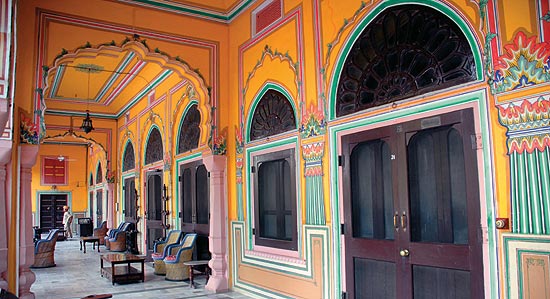
The opulent interiors of Narain Niwas
Further behind the Amber hills is Dera Amer, which provides off-the-beaten-track activity—elephant, horse and camel safaris in the jungle—they also cater group meals and provide tented accommodation but all this obviously comes at a price. And in the keenness to get to Amber, the Kanak Brindavan gardens and Krishna Temple on the Delhi road often get bypassed. Just as the Sisodia Gardens and the Galta Monkey temple do, on the Agra highway.

Ghat ki Guni
Further down the road, just past the Zorawar Singh gate, is one of my preferred jewellery shops—Jewel ‘n’ Arts—in this city that can boast of hundreds, probably thousands, besides the obvious grand Gem Palace, established Tholia’s and innovative Amrapali, all on M.I. Road. This most principal of roads is also where you will find the famed old Lassiwalla (the lassi is delicious but practically a meal by itself), the famed Nero’s restaurant with as good a roast chicken as a rogan josh, Handi, that grew from a popular dhaba into a trendy city restaurant but still serves the same seekh kababs and various other shops and eateries.
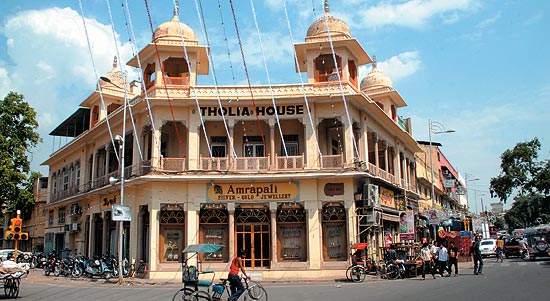
The famous Amprapali at Panch Batti
If it’s your first visit to Jaipur, a visit to Hawa Mahal is mandatory but you can also seize the moment to stock up on your camel leather jootis and lac bangles in the adjoining shops. Also mandatory is a stop at LMB in Johri Bazaar for a good, solid Rajasthani meal or the much-touted sweetmeats. If your tastes incline towards Jaipuri churans and suparis, you should beat your way to J.D. & Sons, where you could also stock up on your bandhni collection at Bapu Bazaar.


Fabric at Nikhar Fashion; and arrays of jewellery at JKJ Jewellers
All the brand shops that either originated or sourced by expanding on the local arts and crafts and designed them into new, innovative must-have ‘ethnic chic’ are aggressively present in Jaipur and with the largest spread of choice, like the well-loved Anokhi with its signature designs (with a delightful Anokhi café next door with vegetarian, mostly organic, mainly western, light meals, snacks and gob-smacking desserts). Anokhi aside, there’s of course Fabindia, Cottons, Soma, Suruchi, Nayika...
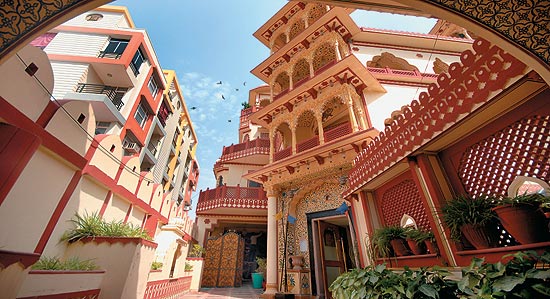
An explosion of colour on the walls of Umaid Mahal
If none of this whets your appetite, back to food—Four Seasons for pure veg multi-cuisine meals, Spice Court on Jacob’s Road in Civil Lines for great locale of sprawling lawns and its kheema bhatti and junglee maas, Mohan Bagh in Narain Niwas for its lal maas, Chokhi Dhani for the complete Rajasthan tourism experience replete with performers and artisans...
One of the small town aspects of the city might seem to be its lack of cool hangouts or watering holes but it is not entirely bereft of choices. While the once booming Steam nightclub in the sprawling Rambagh hotel grounds may have become a sedate and somewhat expensive cocktail and dinner place (with still great wood-fired pizzas), B2B at Country Inns & Suites is still reeling in the younger, spirited souls on to the dance floor, and Tablu, the open rooftop restaurant and bar at the hotel Clark’s Amer not only has great layout and ambience, it often has live music and music festivals. And there’s always loud old-timer familiar music and louder conversation at Henry’s in Park Prime.
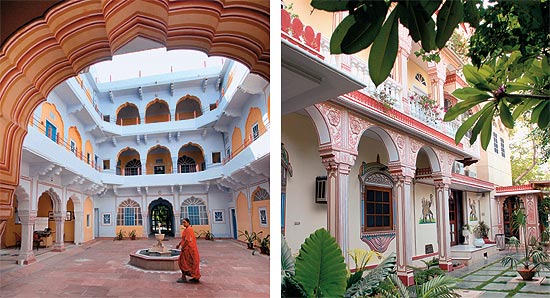
Ethnic feel: The courtyard at Diggi Palace; and Madhuban Hotel
Not too difficult to believe if you take a leisurely walk in Central Park with its broad walking avenue skirting the perimeter, around undulating lawns where you often have open-air free concerts, or the polo field which obviously draws many enthusiasts—all of it once playgrounds for erstwhile royalty.
While you often have bunches of havelis jostling each other in popular neighbourhoods, they each have their signature differences or quirky tenor. Umaid Bhawan and Mahal—sister properties—both have a profusion of colour and reference to every kind of art, sculpture or memory of anything remotely Rajasthani to the point of gaping astonishment, but the same exuberance in décor is repeated in the unflagging enthusiasm and energy of the family towards sustaining their hospitality. In the many-roomed mansion of Shahpura House, with its grandiose darbar hall, I had the felicity of sleeping in a four-poster bed that had once bedded kings—I slept extremely well. Madhuban is a more sedate and contained guesthouse, charmingly tucked away into a verdant garden with neatly built up floors and terraces and an enclosed pool, a quiet and most comfortable getaway. And entirely different in character, in Civil Lines, is Barwara Kothi, an old stalwart-of-a-distinguished-past colonial villa, also family-run, with only seven, but large, tastefully appointed rooms looking out on to expansive lawns.
There are, of course, myriad more choices, old favourites—there’s Narain Niwas where you also get a lovely, large pool, a fully kitted spa and the colourful ‘Hot Pink’ shop with local designer label wear, there’s Diggi Palace whose lawns and darbar are also host to the Jaipur Literature Festival and several other joyous seasonal events (and there are many in the year), the reasonable, practical Arya Niwas, the charming Loharu House, the delightful Alsisar Haveli, but you finally have to stop somewhere for the night—and once you have, most regular visitors, after a bit of dabbling, choose their abode and swear allegiance, much like other visitors choose the carats and facets of glittering diamonds, pretty much like the local resident chooses his sabziwala.
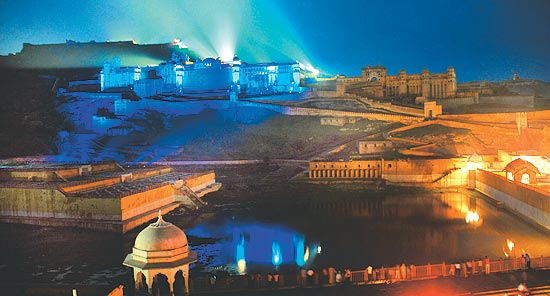









4 comments:
Thanks for sharing such an interesting piece of information. Jaipur city is known for its historic places and heritage culture. For travellers, check out these various hotels in Jaipur offering comfortable accommodation.
Visitors looking for fantasies of regal living in a 200-year-old Haveli will find the Rosakue Bara Bungalow property popularly known as a heritage haveli Jaipur worth spending in. It is a castle that has been intricately sculpted out in Kalwar, Rajasthan, with imposing mountains behind it.
Rosastays Bara Bungalow, also known as heritage haveli Jaipur by visitors who want to live the life of royalty in a 200 year-old Haveli, is a property worth visiting. This castle has been intricately sculpted in Kalwar, Rajasthan.
Indulge in regal grandeur with ROSASTAYS Amer The Barn House, a luxurious bungalow in Jaipur . Experience authentic Jaipur cuisine amidst opulent surroundings. The dining area exudes charm with elegant linen-covered tables, unique wall art, and soft lighting. Enjoy the lush greenery and ample space for barbecue gatherings, bonfire nights, and quiet conversations. Unwind in this oasis of tranquility after exploring the vibrant city of Jaipur.
Post a Comment